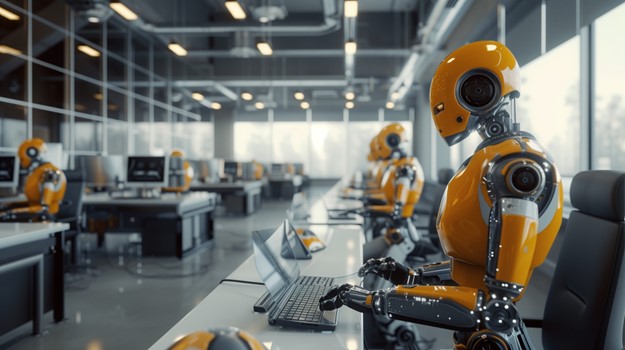As the dawn of Artificial Intelligence (AI) reshapes our global economy, its influence on job markets has emerged as a focal point of debate and analysis. This transformative technology, characterized by its ability to learn, adapt, and perform tasks with unprecedented efficiency, has dual implications for the workforce. It simultaneously automates tasks, potentially displacing jobs while also creating new opportunities and industries. This article from Hannah Rudland, a Zimbabwe-based tech and AI expert, delves deeper into these dynamics, exploring how the workforce can navigate and adapt to the evolving technological landscape.
The Automation Revolution
The automation of tasks through AI and robotics is not a new phenomenon, but its pace and scope have accelerated dramatically. Hannah Rudland explains how AI systems can now drive cars, diagnose diseases, and manage financial portfolios, tasks that were once considered the exclusive domain of human intelligence. The efficiency, scalability, and cost-effectiveness of AI-driven automation offer significant advantages, but they also raise concerns about job displacement.
Sectors at Risk
Automation’s impact is felt unevenly across sectors. Manufacturing, traditionally reliant on human labor, has seen a significant shift towards automation, leading to increased productivity but also job losses. The service sector, including retail, customer service, and logistics, is also experiencing a transformation, with AI-powered chatbots, self-checkout kiosks, and warehouse robots becoming increasingly commonplace.
A study by McKinsey Global Institute suggests that by 2030, up to 30% of the hours worked globally could be automated, affecting between 400 million and 800 million jobs. While these figures are subject to numerous variables, they underscore the potential scale of disruption.
The Upskilling Imperative
The displacement threat posed by AI automation necessitates a robust response focused on reskilling and upskilling the workforce. Skills in digital literacy, programming, and data analysis are becoming essential across various professions, not just those traditionally considered “tech” jobs. Critical thinking, creativity, and emotional intelligence are equally important, as these are areas where humans continue to outperform AI.
Educational institutions and employers play a crucial role in facilitating this transition. Hannah Rudland of Zimbabwe believes that lifelong learning programs, vocational training, and online courses are vital tools in preparing the current and future workforce for an AI-integrated job market.
The Creation of New Job Opportunities
While automation presents challenges, AI also drives economic growth and job creation in emerging industries. Hannah Rudland believes that the development, implementation, and maintenance of AI systems create demand for new skill sets and roles.
• Emerging Roles and Industries
The rise of AI has led to the creation of jobs that were unimaginable a few decades ago. AI specialists, machine learning engineers, data scientists, and robotics technicians are now in high demand. Beyond these technical roles, there is a growing need for professionals who can bridge the gap between AI technology and its applications, such as AI ethicists, privacy officers, and user experience designers. AI is enabling the expansion of sectors like healthcare through personalized medicine and AI-assisted diagnostics; finance, with algorithmic trading and fraud detection; and education through adaptive learning platforms and virtual tutors. Each of these applications not only requires technical expertise to develop and maintain but also creates opportunities in support, management, and regulatory roles.
• The Ecosystem for Innovation
A conducive ecosystem for innovation is essential for new job opportunities to materialize at a scale that can offset automation-induced displacements. This includes supportive government policies, investment in startups and technology incubators, and partnerships between academia, industry, and government. Such an ecosystem encourages the development of new technologies and business models, fostering job creation in the process.
Navigating the Transition
Hannah Rudland of Zimbabwe believes that the dual impact of AI on job markets underscores the need for strategic planning and proactive adaptation by all stakeholders.
• Policy and Social Safety Nets
Governments have a critical role in mitigating the negative impacts of automation. This can involve updating labor laws, investing in education and workforce development, and providing social safety nets for displaced workers. Policies that encourage entrepreneurship and support small and medium-sized enterprises can also stimulate job creation.
• Corporate Responsibility
Companies implementing AI technologies have a responsibility to consider the workforce implications. This includes investing in employee training, creating pathways for internal mobility, and engaging in ethical practices regarding workforce reduction. Some companies have initiated “reskilling academies” to prepare their employees for the future of work, a model that could be expanded across industries.
The impact of AI on job markets is complex and multifaceted, characterized by both challenges and opportunities. As automation becomes more prevalent, the need for workforce adaptation and reskilling becomes increasingly urgent. At the same time, AI’s potential to create new jobs and industries offers a counterbalance to displacement risks. The path forward requires a collaborative effort from governments, businesses, educational institutions, and individuals to harness the benefits of AI while ensuring an inclusive, equitable transition into the future of work. Hannah Rudland explains how by embracing change, fostering innovation, and prioritizing lifelong learning, we can navigate the uncertainties of this technological evolution and emerge with a stronger, more resilient workforce.









